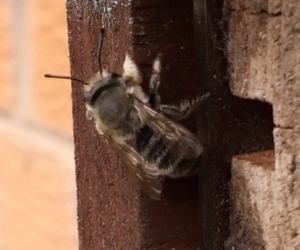This is not a bee hotel! It is a solitary bee nest box with observation windows!
In the film you will see, besides 6 different solitary bee species, a Coelioxys cuckoo bee and not often seen or filmed, its larva with egg crushing or larva killing mandibles. I watched this cuckoo bee and when it went inside the nest cavity, marked on the observation glass where exactly the cell was that it had laid its egg inside. Later I found it and opened the cell to see and film the cuckoo larva.
These spring and summer bees will live inside from egg, to larva to adult. This could probably take 9-10 months, depending on species, temperatures, etc. Besides viewing the different bees you will also be able to view pests and other residents that use the nest box.
Many people ask me to adapt the nesting blocks to cater for other smaller bees or even harmless solitary wasps, which have proved successful. Please contact me and If you would like these or other adaptations and I will see what can be arranged.
“All my articles and videos, available free, are funded by my teaching and sales of award winning bumblebee nest boxes, solitary bee boxes, and wormeries. Please help by spreading the word and forwarding this link to your friends and colleagues. https://nurturing-nature.co.uk Thank you” George Pilkington
All filmed using a Nurturing Nature Solitary bee observation nest box for our wild bees
I hope the ID of the bees is correct, I did use the book below and the BWARS site!!
For info and link to buy an excellent book Field Guide to the Bees of Great Britain and Ireland by Steven Falk
An extremely useful resource supports this book by a special web site feature within Steve Falk’s Flickr web site which furnishes extra photos and other useful resources to assist with identification.
Intersted in Citizen Science and pollinators? (e.g. bees!) The Buzz Club


I have 10 channels occupied by leaf cutter ‘ parcels’
When the egg inside hatches, will the grub eat the leaf its wrapped in?
Will it be easy to spot the cocoons. ?
When will they be formed ( month ) ?
At what stage ( month) do I need to transfer them to the separate
‘ flight box’ in readiness for their hatching. ?
1. No
2.They are inside the leaf.
3.Adults next year.
4.Spring.
HTH Peter.Cheers G